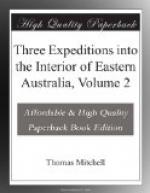Near the beach were holes dug apparently by the natives in which we found the water perfectly sweet. The hills sheltering the most eastern of the two basins were well wooded as were also those behind. The line of sandhills on the beach seemed to rise into forest hills at about five miles further eastward and all those in the west to within a short distance of the coast were equally woody. The day was squally with rain; nevertheless during an interval of sunshine I obtained the sun’s meridian altitude making the latitude 38 degrees 2 minutes 58 seconds South. I also completed by two P.M. my survey of the mouth of the river and adjacent country; and we then again embarked to return a few miles up the river and encamp where wood and water were at hand. On reentering the river from the sea I presented the men with a bottle of whisky with which it was formally named the Glenelg after the present Secretary of State for the Colonies according to my previous intention.
REMARKABLE HOLLOW.
August 21.
We had encamped in a rather remarkable hollow on the right bank at the extreme western bend of the river. There was no modern indication that water either lodged in or ran through that ravine although the channel resembled in width the bed of some considerable tributary; the rock presenting a section of cliffs on each side and the bottom being broad but consisting of black earth only in which grew trees of eucalyptus. I found on following it some way up that it led to a low tract of country which I regretted much I could not then examine further. I found shells embedded in limestone varying considerably in its hardness being sometimes very friable and the surface in some places presenting innumerable fragments of corallines, with pectens, spatangi, echini, ostrea and foraminifera.
LIMESTONE CAVERN.
In the opposite bank of the river I found several thin strata of compact chert containing probably fragments of corallines, not only on the surface but embedded in the limestone. In pulling up the river this morning we observed a cavern or opening in the side of the limestone rock and having ascended to it by means of a rope we entered with lights. It proved to be only a large fissure and after penetrating about 150 yards underground we met with red earth, apparently fallen from the surface. We found at the mouth of the fissure some fine specimens of shells, coral, and other marine productions, embedded in several thin strata of a coarser structure under one of very compact limestone upwards of 20 feet thick.*
(Footnote. In the fragments brought home Mr. George Sowerby found a nucula, very much resembling some species of South America although not like any from Australia. Portions of lucinae, echinus, spatangi, and turritella or melania, were comprised in specimens from a softer stratum which was the lowest.)
ONE FISH CAUGHT IN THE GLENELG.
While the people in the boat awaited us there a fish was taken by Muirhead who had also caught the first fish in the river Darling. That of the Glenelg was a saltwater fish known at Sydney by the name of Snapper.*




